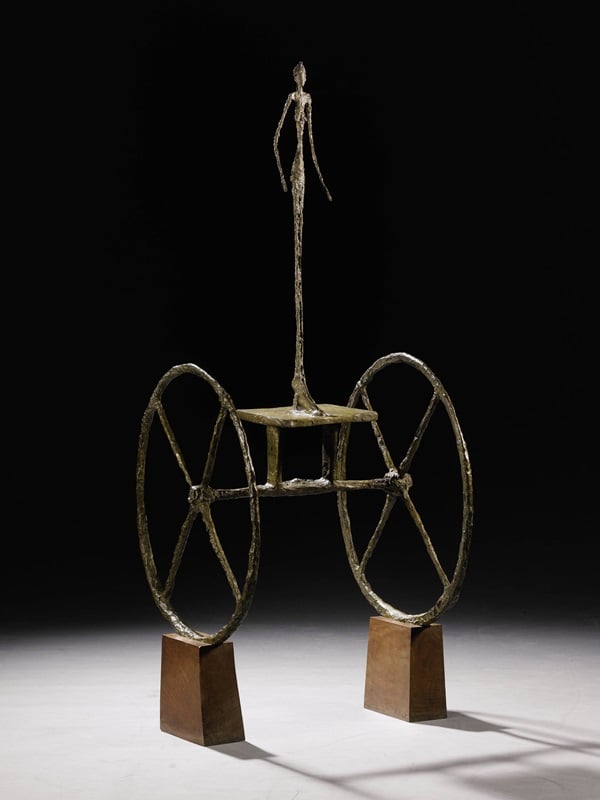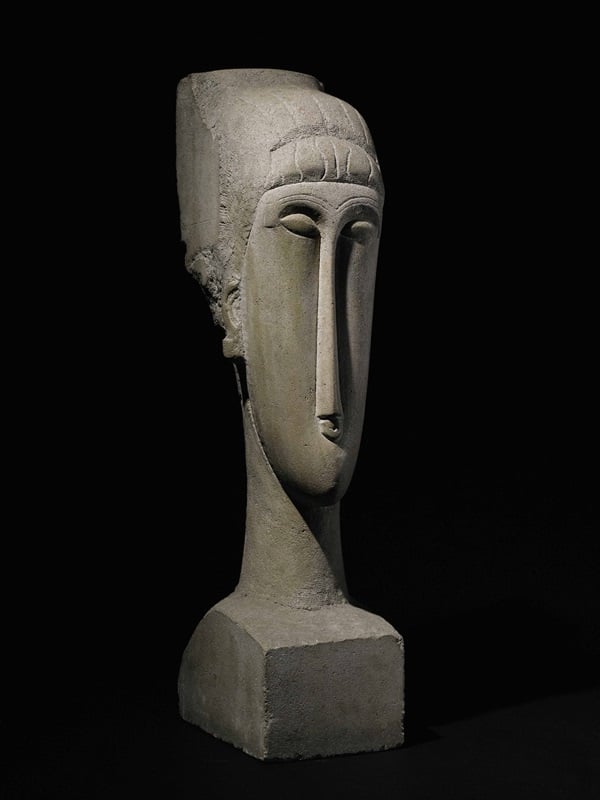Art Guides
$101 Million Giacometti Leads Sotheby’s $422 Million Impressionist and Modern Evening Sale
The auction's highest lot had one bidder.

Photo: Courtesy Sotheby's
The auction's highest lot had one bidder.

Eileen Kinsella

Sotheby’s opened the fall series of New York auctions tonight with an Impressionist and modern evening sale that realized $422 million, brushing up against the high end of the overall presale expectations of $316.5 million–424.9 million and becoming the highest-ever auction total in Sotheby’s history. The sale was 79 percent sold by volume, with 58 of 73 lots finding buyers (one lot was withdrawn prior to the sale). By value it realized 95 percent. Though most of the expected top lots performed well, energy flagged notably in the second half of the auction as a string of lower priced six-and-seven-figure lots failed to elicit any enthusiasm and were bought in, or, failed to sell.
The expected star lot, Giacometti’s Chariot, sold for just over $100 million ($100,965,000). If it’s possible for a sale of an artwork that brought in over $100 million to feel anti-climactic, this one was it. Auctioneer Henry Wyndham opened the bidding at $80 million to what appeared to be not a single bid from the saleroom. Eventually Impressionist and modern specialist David Norman came in with a single bid at $90 million. Wyndham, for what felt like an eternity, kept asking the room if there were any more bids before announcing that he could sell it at $90 million—a sign that the reserve had been met. Not a single second bid emerged and the sculpture was hammered down at $90 million. Despite any palpable feeling of excitement in the room, the final price is the second-highest auction result for a work by Giacometti and the second-highest price for any sculpture at auction.

Alberto Giacometti’s Chariot, which was conceived in 1950 and cast in 1951–52, was expected to sell for more than $100 million. It sold for just under $101 million with premium.
Courtesy of Sotheby’s.
In a lengthy catalogue entry for Chariot, Sotheby’s called it “perhaps the most important bronze the artist created.” The idea for the sculpture came to Giacometti in a flashback to his Surrealist period of the late 1930s, an image that “arrived fully formed and unmediated,” according to Sotheby’s specialists. The artist himself once explained that he was recovering from an accident in 1938 at Bichat hospital in Paris, where he “marveled” at the nurses moving about and pushing pharmacy wagons with tinkling bells. The image stayed with him and he prepared several sketches before eventually creating the sculpture.
The story was the polar opposite for the other star sculptures of the sale. Modigliani’s carved stone Tête (1911–12), which sold for an all-time artist record of $70.8 million, far outpaced its unpublished estimate that was “in excess of $45 million.” The previous record for a sculpture by Modigliani, which come to market far less frequently than his paintings, is $52.6 million. That price was achieved in 2010 at Christie’s Paris. The auction high for a painting by the artist is $68.9 million and was set the same year at Sotheby’s New York.
Bidding opened at $38 million and the sculpture was the target of a protracted bidding war between Sotheby’s specialists Alex Rotter and Lisa Dennison, bidding for their respective clients and duking it out in half-million dollar increments up to about $56 million. Just when it seemed Dennison’s bidder would win it, another Sotheby’s specialist joined the fray for his client and eventually won the work at a hammer price of $63 million.
Due to a lack of money and difficulty in obtaining material, Modigliani was unable to pursue sculpture to the extent he would have liked, experts say. Tête was created from a single block of limestone known as pierre d’Euville, which was quarried in a small town in eastern France. The artist scavenged the material from construction sites around Paris, ferrying it back to the studio he shared with fellow artist Constantin Brancusi in a wheelbarrow. Brancusi reportedly helped out by giving Modigliani instructions for carving.

Vincent van Gogh’s Still Life, Vase with Daisies and Poppies (1890) sold for $62.7 million soaring above its $30 million–50 million estimate.
Courtesy of Sotheby’s.
Another of the most eagerly anticipated lots of the evening was Vincent van Gogh’s late painting Still Life, Vase with Daisies and Poppies (1890), which sold for $61.7 million. It was a high number compared to its $30 million–50 million estimate, which some observers believed was lofty. Bidding opened at $23 million and numerous bidders chased it, including one who entered the competition at $42 million before it was hammered down for $55 million to a Sotheby’s specialist bidding for a client. Prior to the sale, Sotheby’s confidently called it “the most important still life by Van Gogh to appear at auction in more than two decades” and the evening proved them right. See arnet News’ recent in-depth look at the Van Gogh auction market (see: “Do Riches Await In the Van Gogh Auction Market?”). The artist painted the work at the house of his friend Dr. Gachet in Auvers-sur-Oise, where he had settled upon his release from an asylum in St.-Rémy-de-Provence in May of 1890. The artist died in July of the same year.

Amedeo Modigliani’s stone Tête (1911–12) sold for $70.7 million in its first-ever appearance at auction, against an estimate around $45 million.
Courtesy of Sotheby’s.
Claude Monet was well represented here, with three major works all consigned from the same private American collection and a collective presale estimate of around $60 million. They performed well, reeling in $61.9 million in total. These included Alice Hoschedé au jardin (1881), which sold for $33.8 million against an estimate of $25 million–35 million; Sous les Peupliers (1887), a scenic depiction of the French countryside, which sold for $20.3 million on an estimate of $12 million–18 million; and Église de Vernon, soleil (1894), a painting of the tranquil town of Vernon with its “resplendent reflection” in the Seine, which sold for $7.8 million on expectations of $7 million–9 million.
Better Luck Next Time for Kandinsky?
As usual, works making a return trip to the auction block provided something of a barometer for individual artists or artworks. To that end it was not exactly a great night for work by Wassily Kandinsky. For instance the second lot on offer tonight, Kandinsky’s Diagonale (1930), an oil on cardboard, sold for $1.5 million on an estimate of $1.2 million–1.8 million. The consignor who acquired it at Christie’s London in February 2007, paid $2 million or £1 million on an estimate of $1.7 million–2.4 million. But it was bought in when offered in 2012 at Christie’s London with an estimate of $1.9 million–2.5 million. And five lots later, another Kandinsky painting with a $600,000–800,000 estimate was opened at $350,000 and never got off the ground. Bidding stalled at around $440,000 and it failed to sell.
A painting by Pablo Picasso Verre et pichet (1944). that was estimated to sell for $2 million–3 million, sold for $2.85 million. Last offered for sale seven years ago, at Christie’s New York, it sold for $3 million, double the $1.5 million high estimate.
And a brushy Alfred Sisley landscape painting Le Loing à Moret (1883) that sold for $4.9 million on an estimate of $2 million–3 million, was last seen on the auction block at Christie’s New York in May 2005, where it brought in $1.6 million on an estimate of $800,000–1.2 million.